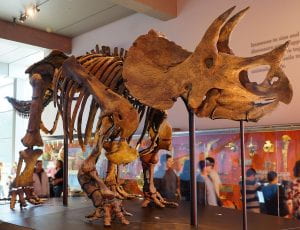
As scientists, we strive to reduce error and bias as much as possible. But as a paleontologist, I need to be aware of the biases I can’t reduce. The fossil record is inherently biased. Not everything that dies becomes a fossil. Not every fossil has been found. Not every fossil stays intact well enough to study. These biases in the fossil record come in many forms and are studied under the branch of paleontology known as taphonomy.
What becomes a fossil? Animals are more likely to fossilize if their bodies are made of hard material (such as calcium carbonate or bone) than if they’re a soft-bodied organism, such as a slug. When a slug dies it decomposes and leaves nothing behind. Therefore, nothing is left to fossilize. These animals only get preserved in particular, rare environments. One example of this are conodonts – basically aquatic slugs with teeth from the Paleozoic Era (498-298 million years ago). Paleontologists found the teeth but could not figure out what they were from–until an imprint of the animal was found, with its teeth in place. The fossils were found in what used to be a quiet lake where the mud at the bottom of the lake encased the animals and preserved impressions of their bodies.
The animal’s location upon dying affects fossilization likelihood as well. Fossilization is more likely if the area has lots of sedimentation and the animal can be rapidly buried (not affected by scavengers). If the animal cannot be quickly buried, the likelihood of fossilization is low, unless the area lacks organisms that will eat/decompose the dead animal. These organisms tend to separate and spread out animal’s bones and shell parts. In addition, there are regions with low sedimentation where sedimentary rocks aren’t created because sediment isn’t being created or transported there. For instance, rocks aren’t being created on top of the ice in Antarctica. So, the animals who live in Antarctica tend not to fossilize when they die, unless their bodies end up in the water.

Assuming the animal does become a fossil, there are still more potential biases introduced before its discovery. Is the fossil in a tectonically active area? If the fossil is in a tectonically active area, then it could be destroyed by lava (on earth surface) or magma (molten rock beneath earth’s surface). If the fossil is not affected by lava or magma, but instead is in an area where the volcanic ash deposits, then it would be covered by great amounts of volcanic ash rock (tuff). This means that it will take longer for overlying rock to erode and expose the fossil, as there is more rock to erode. Researchers often don’t find fossils until they are on the earth surface or have already eroded out of the casing rock and there are fossil pieces on the ground.
Could it be destroyed with faulting (fractures in rock that often allow adjacent rocks to move in opposite directions) or subduction (a plate tectonic process where one plate goes under another and is recycled into the mantle)? Faulting could easily destroy or damage a fossil when two blocks of rock slide past each other. Maybe one rock goes down, or right, and the other rock stays in place. If the fossil is caught between these blocks of rock, it is destroyed or damaged at the very least. Subduction zones (like on the west coast of the US) are places where rocks are recycled. One plate is pushed under another, and the plate that is pushed down enters the mantle (the layer of the earth beneath the crust). Fossils that enter the mantle are scarcely represented in the fossil record. It’s rare for rocks to end up on the surface after being subducted. Yet occasionally, pieces of oceanic crust are found in western Washington, despite being metamorphosed (heated and squeezed in the heat and pressure of subduction). Fossils present in those subducted rocks would either be destroyed or so heavily damaged that they would be very hard to understand.

If the fossil stays intact in the ground, over time erosion will uncover the specimen. Hopefully at this stage, the fossil is found, removed, and placed into a museum setting. Otherwise, it is susceptible to erosion on the surface.
Paleontological surveys have historically been done in certain parts of the world (like North America) typically considered as “developed countries”. Areas that have been politically tumultuous or war-torn lack paleontological data.
Finally, if the animal fossilized, eroded to the surface, and was collected but ended up in a private collection (e.g., poaching or fossil sales) science will never see the specimen.
What do you do if you find a fossil? If you find a fossil (or anything that may be fossil), leave it where you found it. Take a GPS point if you can and notify a museum (or a land office if you find it on public land like a National Forest or Bureau of Land Management Land or a National Park), where the fossil is from is almost more important than the fossil itself. If scientists can’t tell what rock it’s from, they will have a much harder time figuring out how old it is, and it will be nearly impossible to determine its environment.
We will never know everything that has ever lived on the earth. The fossils we do have tell us so much about the past. Everything from dinosaurs to the small fossil rodents have shaped our understanding of earth’s past. Every different fossil is important for science.
Edited by Taylor Woodward and J Wolny

Leave a Reply